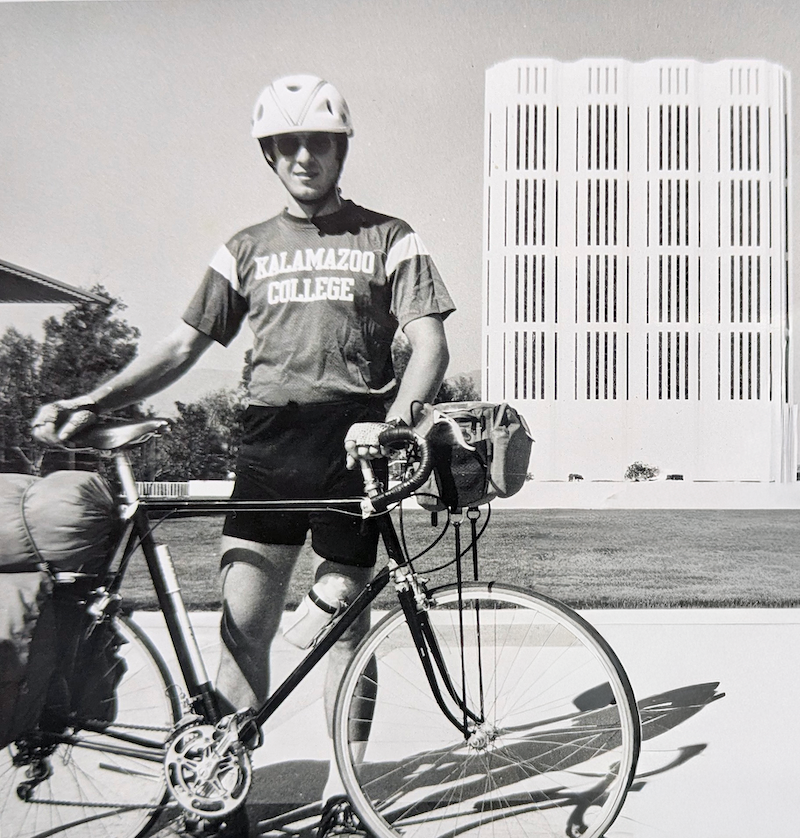Claw Marks on Campus

Blame John Cobb: I made a lame joke and he fake-punched me in the arm, so I overreacted by falling off the barstool. Still, he encouraged me to apply to Claremont, which I did and got in, proof at least the admissions office had a sense of humor.
Going to Claremont matched the advice of several mentors to get out of town, as well as my desire to get far away. I flew west from Michigan to the Claremont campus sight unseen, and was confused by the mustard-colored clouds as the plane descended into Ontario: it was 1978, the air thick with pollution and the promise of an M.Div. This year, the school marks its 140th anniversary (1885–2025), a milestone that connects my arrival decades ago with the long and living history of Claremont School of Theology.
Walking onto campus compounded my confusion: all the classroom doors opened directly to the outside—those crazy Californians, the snow will blow right in! But then I saw Kresge Chapel, and this I understood: the soaring modernist interior had the same soaring pull of a Gothic church, the kind I grew up in. This could work.
The Chapel became my touchstone; I always figured my memorial service would be there. I preached there, making a pointless dig at Dean Joe Hough, who had been our landlord the first year of my marriage. My artist wife Karen and I did our only joint art project there (other than our marriage), designing and painting tall banners to hang around the inside. The class I enrolled with had a bunch of talented musicians and cut a record in the Chapel: although I was a hack pianist, I was invited to accompany on one number, which I messed up, falling off the piano bench (a theme emerges).
And it was my privilege to conduct the memorial service for Sam Maloof there, the artist whose soaring wooden cross hung in the Chapel over the chancel furniture he also crafted. Sam and Freda were our adopted grandparents, and her service was also there; our memories run deep to deepest in that place.
Yet it is “ours” no more. After 40+ years of ministry, you’d think I would have done enough funerals and helped enough people grieve to learn a few things about letting go, but it still gnaws. The best help line has always been from the infamous theologian and recovering addict, Anne Lamott: “Everything we let go of has claw marks on it.”
I feel the oomph of that truth in my gut, a deep rooted holding on, the embers of well-worn desires glowing with vivid memories. Yet that interiority is connected to something outside myself; sometimes it’s another person, or an experience, or a place—even a building— that sinks its claws into me, in a good way. He, she, they, and even it become embedded within, a mutual embracement. So of course the claw marks go both ways: the letting go leaves marks on us.
A few weeks ago, for our anniversary, Karen and I did a weekend nostalgia tour around southern California on our motorcycle (shout out to professor Jack Coogan for helping get me on two motorized wheels) and we rolled by the original campus across from Wolfe’s Market—more memories! The Chapel stood vigil behind the old billboard sign, stripped of its letters; but shadows of the words “School of Theology” still showed. I felt the stretch and sting of reciprocal claw marks.
In my head, I thought “C’mon, you’re a Methodist preacher—you’re itinerant by design, you should be able to walk away from any place, anytime; how else to ‘go on to perfection’, wherever that might be?!”
But the claws were real. Only later did a bit of text from Paul emerge from the depths: something about how Jesus did not consider his divinity “something to be grasped, but emptied himself…” (Philippians 2:6-7)
OK, ok, I’ll keep working on the letting go. I do know that in time, if we lean into the emptiness, there comes something which can never have claw marks on it: gratitude, for what has been, and what will be. Thanks, Claremont – and happy 140th anniversary!
Rev. Gary M. Keene is a retired United Methodist clergy living in Ventura, CA.
Over forty years in ministry, Gary served eight diverse congregations in southern California, and was the executive in connectional ministries for three annual conferences in the Western Jurisdiction. In addition, he wrote and taught nationally for the General Board of Discipleship, and was National Director of Camping for the GBOD; he remains an active hiker and cyclist.
Ways to Support CST
Scholarships for Students: Open doors for future pastors, chaplains, counselors, and nonprofit leaders by easing the burden of tuition.
Faculty and Research: Sustain world-class faculty who shape bold, justice-centered scholarship and mentor the next generation of leaders.
Program Innovation: Help launch and strengthen pioneering programs like the Doctor of Spirituality and Doctor of Professional Counseling, preparing leaders for new arenas of ministry and service.
Claremont Circle of Compassion: Join CST’s monthly giving community and provide steady support for the mission of compassion, justice, and belonging.
Every gift—large or small—helps form leaders who will answer the call to justice.

